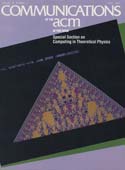April 1985 - Vol. 28 No. 4

Features
As computers become more powerful and sophisticated, computational astrophysicists will be able to find out more about stellar evolution and other astronomical phenomena.
Monte Carlo methods in theoretical high-energy physics
Although lattice field theorists have been able to develop new approaches to the Monte Carlo method and to successfully apply them in Bosonic calculations, faster and larger computers are needed for Fermion-field evaluations.
Statistical mechanics and disordered systems
Since computers are able to simulate the equilibrium properties of model systems, they may also prove useful for solving the hard optimization problems that arise in the engineering of complex systems.
Experimental mathematics: the role of computation in nonlinear science
Computers have expanded the range of nonlinear phenomena that can be explored mathematically. An “experimental mathematics facility,” containing both special-purpose dedicated machines and general-purpose mainframes, may someday provide the ideal context for complex nonlinear problems.
Special-purpose processors in theoretical physics
Specially designed processors can provide a method for attacking some of the difficult computational problems facing theoretical physicists.
Symbolic mathematical computation
Standard programming languages are inadequate for the kind of symbolic mathematical computations that theoretical physicists need to perform. Higher mathematics systems like SMP address this problem.
A class of sorting algorithms based on Quicksort
Bsort, a variation of Quicksort, combines the interchange technique used in Bubble sort with the Quicksort algorithm to improve the average behavior of Quicksort and eliminate the worst case situation of O(n2) comparisons for sorted or nearly sorted lists. Bsort works best for nearly sorted lists or nearly sorted in reverse.
Amortized analyses of self-organizing sequential search heuristics
The performance of sequential search can be enhanced by the use of heuristics that move elements closer to the front of the list as they are found. Previous analyses have characterized the performance of such heuristics probabilistically. In this article, we use amortization to analyze the heuristics in a worst-case sense; the relative merit of the heuristics in this analysis is different in the probabilistic analyses. Experiments show that the behavior of the heuristics on real data is more closely described by the amortized analyses than by the probabilistic analyses.
A generalized implicit enumeration algorithm for graph coloring
A generalized algorithm for graph coloring by implicit enumeration is formulated. A number of backtracking sequential methods are discussed in terms of the generalized algorithm. Some are revealed to be partially correct and inexact. A few corrections to the invalid algorithms, which cause these algorithms to guarantee optimal solutions, are proposed. Finally, some computational results and remarks on the practical relevance of improved implicit enumeration algorithms are given.



